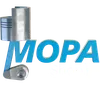INSULATING MAT damping elements for high-performance marine and diesel engines
Damping elements are engineered components that decouple vibrating sources from surrounding structures. In engine rooms and on propulsion or genset skids, they absorb and isolate shock, vibration, and noise, protecting the foundation, piping, instruments, and hull from harmful dynamic loads. From resilient mounts and bushings to pads and the INSULATING MAT beneath enclosures and covers, these parts are critical to stable operation, lower noise emissions, and a longer service life for marine and industrial diesel engines.
Technical function: how damping elements and INSULATING MAT work in a marine engine
In practical terms, damping elements create a tuned elastic interface between the engine and its baseframe. By selecting the right stiffness and deflection, the system’s natural frequency is kept well below the excitation frequencies of the diesel engine (idle to rated rpm), reducing transmissibility and preventing structure-borne noise from migrating into decks, bulkheads, and auxiliary systems. Elastomeric mounts (often NBR, CR, or EPDM blends) and laminated steel-rubber elements dissipate energy as heat, converting cyclic forces into manageable, low-amplitude motion. Metallic spring-damper assemblies may be used where higher static loads or elevated temperatures are present.
The INSULATING MAT for marine engine installations complements mounts by adding broadband vibration damping and acoustic absorption under covers, acoustic hoods, or control cabinets. Properly specified mats also provide thermal insulation around hot zones, reducing heat soak and improving safety. In exhaust systems and auxiliary drives, smaller damping elements—stops, buffers, and bushings—control peak forces during start/stop, load steps, and torsional events. For enclosure panels and cable trays, an INSULATING MAT OEM parts solution minimizes panel resonance and reduces airborne noise, improving crew comfort and compliance with shipboard noise requirements.
Key characteristics and advantages of damping elements
· Tuned stiffness for target natural frequency and low transmissibility.
· Stable Shore hardness for consistent deflection under load.
· High resistance to oil, fuel, salt spray, and coolant.
· Temperature stability for engine-room conditions.
· Fire-retardant and low-smoke options for marine compliance.
· Corrosion-protected metal parts and bonded interfaces.
· Fail-safe designs for controlled movement under overload.
· Acoustic absorption to reduce panel and enclosure noise.
· Easy replacement with predictable fit and height control.
· Traceable materials and documented performance data.
Importance for engine operation: why damping elements matter
Uncontrolled vibration accelerates fatigue in brackets, foundations, and welded structures. Worn or hardened damping elements raise the natural frequency, increasing vibration levels at the engine feet, which in turn promotes misalignment of couplings, premature bearing wear, and shaft seal leakage. Excess noise and structure-borne vibration can lead to loose fasteners, cracked exhaust bellows, instrument drift, and operator fatigue. If an INSULATING MAT loses elasticity or delaminates, enclosure panels can resonate, surface temperatures may rise, and noise emissions increase—potentially breaching vessel or plant limits. Keeping damping elements in sound condition directly supports reliability, efficiency, and safety across the propulsion train and auxiliaries.
Advantages of OEM spare parts suitable for damping elements and INSULATING MAT
Using OEM parts suitable for your engine model ensures that dynamic stiffness, static load capacity, and geometry match the manufacturer’s design envelope. Compound formulation, bonding processes, and metal hardware tolerances are controlled so the installed height and deflection remain within spec, maintaining shaft alignment and minimizing transmissibility across the operating range. INSULATING MAT OEM parts for diesel engine and marine engine applications feature verified acoustic absorption coefficients, correct thermal conductivity, and surface finishes that resist oils and cleaning agents.
From a cost and uptime perspective, correctly matched OEM spare parts reduce commissioning time, prevent trial-and-error tuning, and extend service intervals through predictable aging and compression set behavior. Consistency across sets—front/rear mounts, lateral stops, and enclosure mats—keeps vibration balance even, protecting sensitive components and lowering total lifecycle cost. With documented test data and compatibility to adjacent components (stops, shims, height adjusters), procurement is straightforward and technical risk is minimized.
MOPA as your partner for OEM parts: damping elements and INSULATING MAT
MOPA supplies OEM spare parts suitable for damping elements and INSULATING MAT solutions for diesel and gas engines with speed, quality, and security. Our team supports selection based on engine mass, center of gravity, target deflection, and installation footprint, helping purchasers and technical managers specify the right set for marine engine skids, generator frames, and enclosure systems. We provide rapid availability, clear documentation, and dependable logistics, ensuring that critical vibration isolation components arrive on time and ready to install. With MOPA, you gain a reliable partner for sourcing OEM parts that maintain performance and protect assets in demanding engine-room environments.
INSULATING MAT for diesel engine and marine engine: selection notes
When specifying an INSULATING MAT or related damping elements, define static load per support, target natural frequency (typically below main excitation orders), and environmental exposure (oil, salt, temperature). Consider flame-retardant grades for shipboard use, verify panel bonding methods for enclosures, and match thickness to the desired absorption band. For mounts, confirm bolt size, fail-safe requirements, and installed height to preserve alignment and avoid pipe strain. Periodic inspection—checking hardness, cracks, and permanent set—keeps the isolation system within design performance.
Conclusion: damping elements and INSULATING MAT keep engines efficient
Damping elements, including the INSULATING MAT, are essential to controlling vibration, noise, and thermal effects in marine and diesel engines, directly influencing reliability, efficiency, and safety. Selecting and maintaining OEM spare parts suitable for damping elements preserves engineered performance, reduces downtime, and extends service life—benefits that protect both budgets and critical assets.

